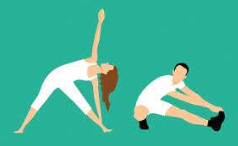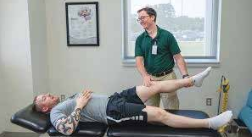
Stretching is a fundamental component of many physiotherapy rehabilitation programs. It also is something that people often have many questions about. It involves performing specific movements designed to increase flexibility, improve range of motion, alleviate muscle tension, and enhance overall physical function. Physiotherapists often tailor stretching routines to target specific areas of the body affected by injury, pain or restricted mobility.
Stretching can vary widely depending on the individual’s condition and treatment goals. There are several types of stretching techniques, each with its own benefits and purposes. Here are some common ones:

1. Static Stretching:
This involves stretching a muscle to its farthest point and holding that position for a set amount of time, usually around 30 seconds. It’s commonly used in flexibility routines and can help improve overall flexibility.
2. Dynamic Stretching:
Dynamic stretching involves moving parts of your body through a full range of motion repeatedly. It’s often used as part of a warm-up routine before exercise to improve flexibility and prepare muscles for movement.
3. Ballistic Stretching:
This involves bouncing or jerking movements to force a muscle beyond its normal range of motion. It’s considered more risky than other forms of stretching because it can cause muscle strain or injury if not done properly. It’s generally not recommended, especially for beginners.
4. PNF (Proprioceptive Neuromuscular Facilitation) Stretching:
PNF stretching techniques involve a combination of stretching and contracting muscle groups. There are several variations of PNF stretching, but they typically involve contracting a muscle for a few seconds while it’s being stretched, then relaxing and stretching it further. This can help improve flexibility more effectively than static stretching alone.
5. Active Stretching:
Active stretching involves using your own muscles to stretch a muscle group. It requires strength and control and is often used to improve flexibility and range of motion.
6. Passive Stretching:
Passive stretching is when an external force, such as a partner or a prop like a strap, is used to stretch a muscle. The individual being stretched is generally relaxed while the external force provides the stretch.
Each type of stretching has its own benefits and is appropriate for different situations and goals. It’s important to choose the right type of stretching for your needs and to perform them correctly to avoid injury- if you are not sure a Physiotherapist can help. One thing to note with any stretching, is that the stretch should not be painful- it can be intense, but should not cause pain.
Stretching can benefit various conditions, such as:

1. Muscle Strains: Stretching can help to alleviate muscle tightness and promote healing after a strain or tear.
2. Joint Stiffness: Stretching exercises can improve joint mobility and reduce stiffness, particularly beneficial for conditions like arthritis.
3. Postural Imbalances: Stretching tight muscles and strengthening weak ones can help correct postural imbalances and reduce associated pain.
4. Rehabilitation: Stretching is often included in rehabilitation programs following surgery or injury to restore flexibility and function.
5. Prevention: Regular stretching can help prevent injuries by maintaining flexibility and range of motion.
It’s essential for individuals to perform these stretches correctly and under the guidance of a qualified physiotherapist to ensure they are safe and effective. Overstretching or performing stretches incorrectly can potentially exacerbate existing issues or cause new injuries.
If you have any questions about if stretching is right for you, or what specific stretching might help you reach out to Donald Physiotherapy! We are here to help. Give us a call at 306- 933-3372.
-Megan Lautner

Leave a Reply